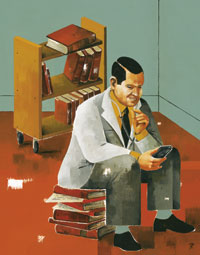S
T A N F O R D ![]() M
E D I C I N E
M
E D I C I N E
|
S
T A N F O R D |
| Volume
18 Number 2 Fall 2001 |
index

|
|
Short
Take:
Mobile med |
|
Stanford medical student Shannon Moffett has seen the future — and nowhere in that vision does she see the stacks of books and piles of paper that medical students have traditionally hauled around. Instead, she sees a small hand-held device that puts a rich catalog of medical resources at the fingertips of future doctors, enabling them to access information as they move from the classroom to the laboratory and into clinical settings. Moffett is the student leader of a program launched last fall to equip 240 Stanford medical students with Palm Vx organizers that integrate digital and Web-based learning into their education while familiarizing them with a future tool of medicine.The program, Stanford Mobile Med, is supported by Lane Medical Library and through development agreements with some of the biggest names in personal digital assistant, or PDA, software providers. Associate professor of medicine Phyllis Gardner, MD, the medical school’s senior associate dean for education and student affairs when the program was launched, believes that doctors will increasingly rely on PDA-type devices. “Instead of the notebook that physicians traditionally carried around, future doctors will have PDAs to access patient histories, results of physicals, other electronic medical records and laboratory information,” she says. “We’re training students for that.” First steps Already available for download by students is Stanford-specific content that includes electronic “flashcards” and class-specific study materials, lecture schedules and contact lists for classmates and administrators. Moffett also developed a file that contains the “normal” lab values for Stanford Hospital. “Each hospital has slightly different values of what’s considered a ‘normal’ result on a specific test,” she says. “It’s just a simple little file, but when it’s on a PDA, you don’t have to worry about tracking down the piece of paper with the lab values on it.” “A PDA is never going to replace a thinking brain or a doctor, but it’s going to replace a lot of paper,” Moffett adds. “And that’s what’s so great.” A co-development agreement with AvantGo, a Web-clipping service, provides a distribution channel on which Stanford medical students can automatically receive updated class information through their PDAs whenever they sync, or load, the software. Class announcements, daily assignments and the like are distributed through the service, which was implemented in May. Another collaboration, with the company FirePad, has allowed Mobile Med programmers to convert electron micrographs, CT-scans and X-rays into a high-resolution formats for PDA devices. Also, ePocrates is offering PDAs at reduced prices to the Stanford medical school community to familiarize them with the company’s drug interaction database. Beyond the pilot program’s initial offering, students will likely need to purchase their own PDAs. The program, updated daily and downloaded for free to PDAs, reports interaction data on any number of selected drugs — information that is difficult to memorize, frequently updated and convenient for physicians to have at their fingertips. “The nature of medical education for students is so very time-intensive that for pre-clinical students the PDA is a great tool to manage their time,” says Todd Grappone, the head of computing and network services for Lane Library. “This allows them to study virtually anywhere.” On the horizon Still in the discussion phase is a plan to use Webpads (a screen the size of a notebook, with wireless Web access) and software that prompts a user along the decision tree while a patient’s medical history is taken — a lengthy process that requires much practice. The technology ultimately may be used as a teaching tool or even as a way for patients to record their own medical histories. The school is also working with a company called Clarinet to incorporate a wireless technology that’s based on infrared, rather than microwave, signals. The more common cellular wireless technologies can’t be used in some clinical settings because of interference with clinical equipment. While other schools are using PDAs selectively in hospital situations, Stanford may be the first to incorporate use of the technology into classroom situations. “We’ve tried to Web-enable as much of our curriculum as possible,” says Gardner. “We already have our current curriculum on the Web with streaming video for every lecture available within 24 hours, along with all associated course materials and lots of very rich libraries of media that have been digitized. A lot of internet technology specialists have been here for years, so we have a very strong group of software and Web developers.” SM |
|
|
Home |
|
This document was last modified:
Wednesday, 31-Dec-1969 16:00:00 PST
|
|